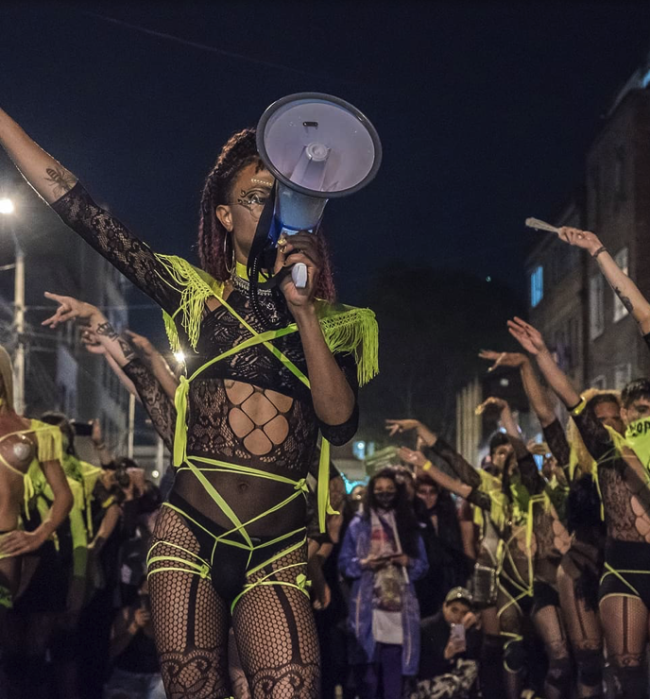
In a video posted on Instagram from a 2021 protest in Bogotá, Colombia, a woman straddles the front of a police officer’s motorcycle as the officer sits mounted in the saddle. The officer is dressed in layers of black and green protective gear, while the protester wears a much more revealing outfit in the same neon green colors. The disrupter is a member of the radical trans-marika collective Topologungo. She uses her body as a weapon to physically block the motorcycle’s movement. In doing so, she disempowers the officer with the force of her body and her sexuality.
The Toloposungo member’s intervention is explicitly sexual; while the officer contends with the physical weight of another person straddling his phallic motorcycle, she sexualizes the vehicle and destabilizes the officer. The action calls attention to and subverts the ever-present sexual undertones of police violence. As she takes back her power, we see the police officer contend with queer and trans “force.”
The video then cuts to an unmanned police motorcycle lying in the street, surrounded by a group of protesters kicking it. The motorcycle has been smeared with red paint, symbolizing the trans and queer blood that has been spilled through police brutality. This final scene suggests the officer’s power, the motorcycle, has not just been destabilized, but toppled. While the action has momentarily disrupted the officer’s control over the vehicle in real time, the video on Instagram disrupts it in perpetuity (or until the post is removed).
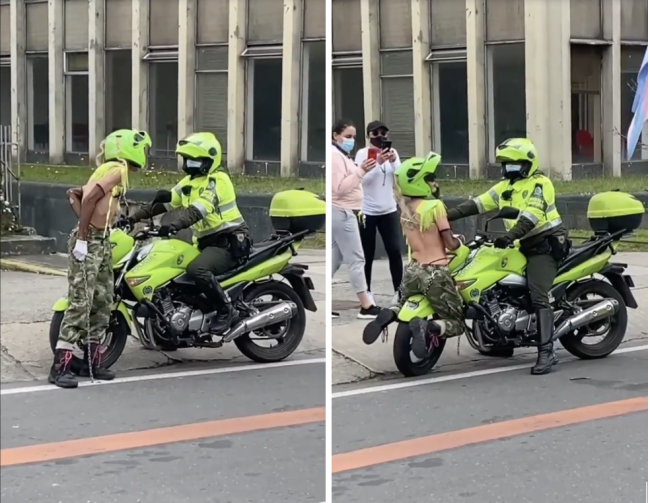
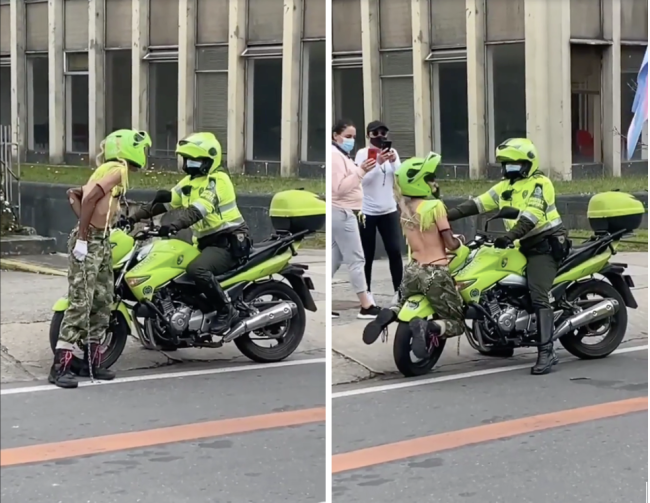
Topolosungo is a group of trans-marika activists, performers, and abolitionist organizers that banded together during the presidency of Iván Duquel Marquéz (2018-2022), a period marked by extreme inequality, government impunity, corruption, and violence. In a context of generalized protests that broke out across the country, the group organized to denounce police and state sanctioned violence against trans and gender non-conforming people. In their protests and collective praxis, members of Toloposungo employ choreographed and improvised movements, like voguing and cat walking, to disempower the institution and fight back against police brutality.
First sparked in April of 2021 and eventually known es the estallido social or social uprising, protests against government corruption and widespread inequality were staged across the country. These protests were met with extreme government violence, including the disappearance and murder of protestors. In 2020, the Institute for the Studies of Peace and Social Development in Colombia recorded 91 massacres throughout the country, in which 381 people lost their lives. Between April 28 and May 31 of the following year, the NGO Temblores recorded 3,789 cases of police violence; of these cases, 45 were categorized as murders, more than half of which were committed by police officers and members of ESMAD (an anti-riot unit), as confirmed by the UN Human Rights Comission.
The LBGTQ+ community in Colombia was an important part of this uprising. Despite the decriminalization of homosexuality in Colombia in 1981 and a series of subsequent laws in the 21st century that claimed to offer protection for LGBTQIA+ Colombians, the queer and trans community continues to be disproportionately affected by inequality and violence. Within this context of ongoing social protest and organizing, Topolosungo used techniques of queer activism to both support the protests and their demands, and to call attention to the unique forms of violence and police brutality faced by trans and gender non-conforming people.
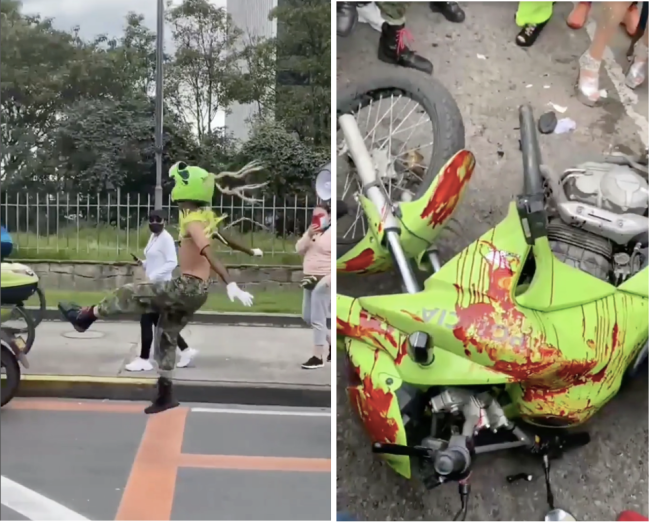
“Toloposungo” is derived from the first syllables in each word of the Spanish phrase “todos los policias son una gonorrhea” (all cops are gonorrhea). The name carries at least two meanings. It plays on the common Colombian usage of gonorrhea as shorthand for a cruel, disliked, and evil person. The name also signals both an embrace of transnational abolitionist movements and an anti-colonial critique of the misogyny inherent in the English phrase “all cops are bastards” (ACAB). As the activist, founder of La Red Comunitaria Trans, and Toloposungo member Daniela Maldonado Salamanca points out on Sur-Urbanos’ podcast episode, “Abolicionismo, Activismo Trans y Toloposungo”: “Los tombos hijos de puta no porque las putas no parimos” (cops are not sons of prostitutes because we don’t give birth”). Instead of adopting the misogynistic language of the English phrase ACAB, Toloposungo retains and revises its abolitionist impulse within a Colombian context to attend to the values of the movement. By identifying the police themselves as a social gonorrhea, Toloposungo transfers the sexual and pathologizing charge that gender non-conforming people receive in the public sphere onto the police. In doing so, they disempower state authority and empower their own movement.
“El Vogue es Revolución”
In addition to challenging institutional power and police violence through their naming practices, Toloposungo’s styling aesthetics further challenge the authority of Colombia’s police and military. In their public interventions, members of Toloposungo wear black and neon lime-green outfits, mirroring the colors used by Colombia’s National Police on uniforms and vehicles. When used by the police, these colors are arranged in solid patterns on “protective” gear, like bullet-proof vests. The shared gear and colors conceal the bodies of police officers and anonymize each individual, adding to the aesthetic impression of force.
Members of Toloposungo, on the other hand, subvert these colors by using them for small and tight outfits with transparent materials, like fishnets, lace, and mesh. They also employ the symbols of police and military institutions like lime-green epaulettes, chains, camouflage pants, combat boots, and police helmets. Their outfits create a distinct uniform-like aesthetic that differentiates them from the cops by virtue of the exposure of flesh and a shared vulnerability. Whereas cops use hard and opaque materials to protect and cover their bodies, Toloposungo exposes their flesh, marking their gender and sexual dissidence in public. This exposure indexes a shared vulnerability to gendered police violence for the Colombian LGBTQ+ community. While the National Police Force of Colombia has claimed that they use green to symbolize hope, Toloposungo’s revision of this color scheme demonstrates that there are two very different hopes for Colombia at play: for the police, the maintenance of a social order that marginalizes and imposes violence and death on gender non-conforming people, and for Toloposungo and their allies, the abolition of state violence.
Despite the difference in material and coverage between the police and Toloposungo members, the shared use of florescent green causes their bodies to blend together in public spaces—a blending that visually dilutes and obfuscates the police’s singular hold on power and force.
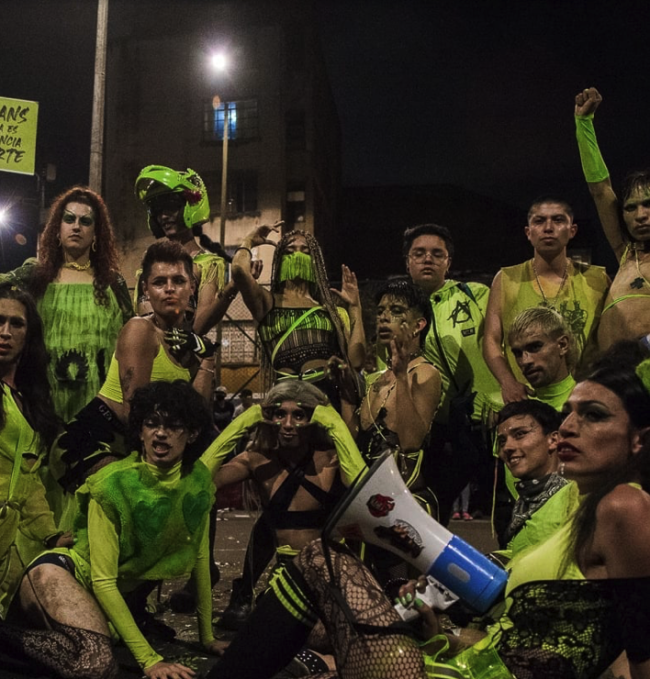
The group’s styling choices present them as a paramilitary force—yet, this is a guerrilla-style unit that mobilizes art and collective action instead of violence and weapons. As Toloposungo points out in an Instagram post from May 14, 2021, “Vogue is a revolution and it’s time to continue using it as a lethal weapon against a rotten institution that violates us, kills us, and riddles us [with bullets]”. In this way, the group not only calls for the abolition of state-sanctioned violence, but radically reimagines and enacts a tomba trans-marika del futuro—a trans-marika force of the future. In Colombia, the word tombo/a is used pejoratively to refer to the police and other untrustworthy authorities. Toloposungo’s reappropiation of the word signals skepticism towards other potential institutional and authoritative replacements. A tomba trans-marika disempowers and parodizes state violence in the future, conjuring a vision of social life that is maintained through collective collaboration that values and centers trans-marika art and experience.
Rather than using their bodies to harm others, as the police do, members of Toloposungo put their bodies on the line (ponen les cuerpes) to expose and resist police violence. They expose their flesh and utilize the gender dissidence and queerness of their bodies as a form of non-violent combat against police brutality—often by directly engaging with the police by blocking their movement. We see this clearly in the intervention that opens this essay; the Toloposungo protester uses her body to inhibit, subvert, and disrupt state sanctioned violence against dissident bodies.
Toloposungo members also combat police violence through public voguing performances. Originated by trans and queer people of color in New York City’s ballroom scene in the 1980s, vogue is a dance technique in which dancers choreograph a series of angular movements resembling fashion poses. Over time, the dance has adopted different variations, gaining a degree of mainstream recognition while remaining rooted in the underground queer and trans of color ballroom scene. As a dance technique, voguing is unique in that it is both choreographed and improvisational.
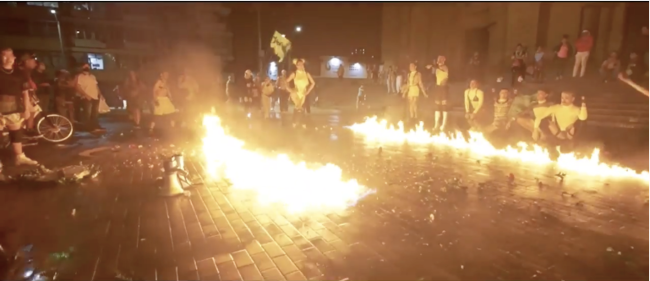
Toloposungo members, several of them ballroom performers in Colombia, have taken up voguing in their artistic practice. The vogue performed by the group reflects the unique variation of the dance that has developed in the country’s own queer and trans ballroom scene, mixing New York style vogue with other styles like perreo and mariconeo. Toloposungo members use this blended style to choreograph dances in protest of police brutality and institutional violence. They also strut and vogue in unison, like a marching army, using a megaphone to denounce police brutality and call for its abolition. At protests and marches, they also improvise voguing movements next to and around police officers, as well as adopting other elements of ballroom performance to the public protest space—such as improvising a runway demarcated on asphalt by gasoline lit on fire. Through these elements of performance, Toloposungo members assert their place in Colombia’s public sphere—not with violence, but with art, with beauty, and with joy.
Transversal Organizing
At the height of protests against the Duque presidency and the systemic inequality his administration came to represent in Colombia, Toloposungo performed among crowds of citizens, some of whom had no affiliations or relation to the country’s LGBTQ+ community. The collective works transversally across social lines to mobilize collective action. Within an organizing framework, transversality is understood as the act of working collectively with others to cut across social difference—not only in the interest of speaking to power, but also to promote dialogue across and between difference. We find an example of transversal organizing in Toloposungo’s performance at Plaza Botero in Medellín, Colombia on August 26, 2021. For this intervention, Toloposungo joined the efforts of Putamente Poderosas, a collective that defends and advocates for the human rights of sex workers and their families in Medellín. Putamente Poderosas enacts this advocacy by creating an intergenerational and intersectional dialogue between sex workers and other members of the local community.
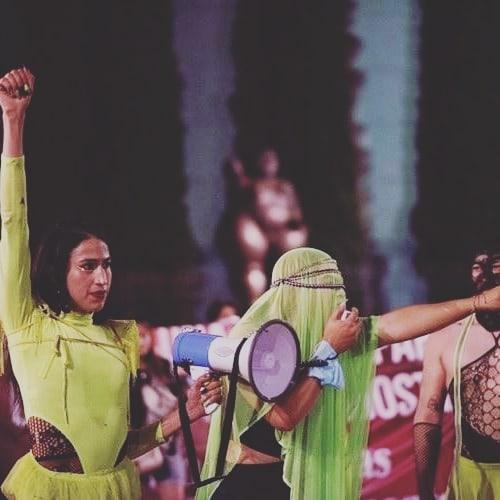
That August, the city of Medellín had erected a metallic enclosure around Plaza Botero, a park heavily utilized by sex workers and other disenfranchised community members for business and social connection. Putamente Poderosas and Toloposungo staged a protest and a performance to call for the removal of the fencing and for dialogue between the authorities, community members, and sex workers concerning the park and the public use of space. As Melisa Toro, co-founder of Putamente Poderosas called through a megaphone to a crowd of people: “¡Sin las putas no hay Plaza Botero. Sin las putas no hay revolución!” (Without sex workers there is no Plaza Botero! Without sex workers there is no revolution!). Toro’s statement underscores the fact that sex workers are an integral part of the community and identity of Plaza Botero as a commons, and that true social change is not possible without their defense and inclusion.
The performance by Toloposungo included a mixture of voguing, opera singing, and a declaration of Toloposungo’s manifesto for an end to systemic police violence against trans and gender non-conforming people. The group can be heard singing “Toloposungo, all cops are gonorrhea” over house music, energizing the crowd. While some of the members vogue, others shout into megaphones: “¡Abolición policial! ¡No es una manzana! ¡Es todo el árbol! ¡Institución podrida! ¡Qué el amor sea el arma más letal!” (Police abolition! It is not an apple! It is the entire tree! Rotten institution! Let love be the most lethal weapon!). In their performance, Toloposungo is not only working toward safety and visibility, but for the rights of trans people and sex workers to occupy the streets and not be displaced or marginalized.
While the performance by Toloposungo and Putamente Poderosas calls for an end to police violence through the experiences of trans individuals and trans sex-workers, their protest against the metallic enclosure goes beyond these identity groups, also asserting the rights of non-trans sex workers and street vendors who call the park home. Plaza Botero is a space transited and inhabited by many different people who come together through labor and leisure to create its social identity, and whose ability to access work and community was affected by the enclosure. Putamene Poderosas and Toloposungo’s protest acknowledges these mutliple relationships to space.
In addition to protests such as this one, Toloposungo works transversally through community gatherings like ollas populares (community kitchens) and abolitionist workshops. In these gatherings, the group provides meals to the community writ large and free of charge without consideration of identity or occupation. In this way, Toloposungo works to create dialogue across social difference—not only for the purpose of amplifying their message for police abolition, but for the strengthening of connections with various, seemingly unrelated groups that also suffer state violence.
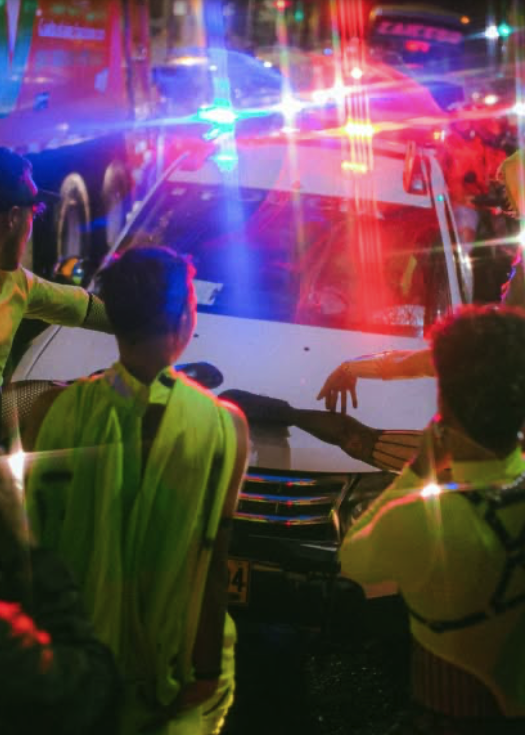
If Toloposungo vogues and performs as a call for police abolition, this is a call that benefits the larger Colombian population. During the social protests of 2020 and 2021, Colombia saw a rise of disappearances and murders of protestors and social leaders who opposed the corruption of Duque’s government. Toloposungo’s call to abolish police violence, therefore, is a transversal call with the wellbeing of the larger population in mind. In other words, Toloposungo dances in the face of violence to end violence for all.
Regional Resonances
Toloposungo’s transversality is both local and connected to a broader South American transfeminist ideology and praxis—a movement that understands trans experiences and knowledge as central to the feminist cause. As much as Toloposungo’s work is in dialogue with abolitionist and street art movements in the Global North (ACAB and vogue), their work is also inspired by and has connections to other South American transfeminist currents of artist and activist collectives who intervene in the public sphere. For instance, the way in which members of Toloposungo put their bodies on the line to denounce institutional and systemic violence is reminiscent of the Chilean feminist collective Las Tesis.
Las Tesis is a trans-inclusive feminist collective that took shape in 2018 during Chile’s own estallido social that opposed the neoliberal policies implemented by the government of Sebastián Piñera. Like Toloposungo, Las Tesis channelled the energy of the moment into a performance. On November 20, 2019, Las Tesis performed “Un violador en tu camino” (A rapist in your path) in Valparaíso, Chile. In the performance a group of women and gender dissidents denounced gender-based violence in the middle of a public square in a flash-mob style. Inspired by experiences of police and systemic violence, they called out the mysoginistic trope that women are responsible for their own sexual assault by intentionally wearing outfits that some would consider provocative. During the intervention, La Tesis members covered their eyes and squatted down, echoing the blindfolds and stress positions that occurred during the systemic kidnappings, disappearances, and sexual abuse committed by the police during Augusto Pinochet’s dictatorship from 1973 to 1990.
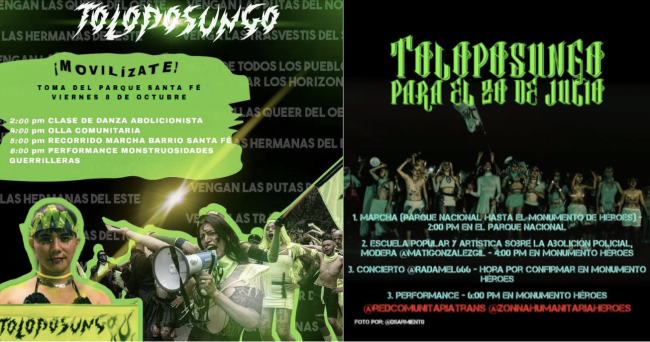
Las Tesis’s aesthetics of public visibility and denunciation are similar to those of Toloposungo, in which both collectives make their bodies hyper visible to highlight their message of vulnerability and state violence. We can consider this a regional tactic, in which the feminine and gender dissident bodies’s vulnerability is exposed to highlight injustice.
While the performances by Las Tesis and Toloposungo share an emphasis on police violence over women and gender/sexually dissident bodies, they differ in how they were received in other parts of the world. “A Rapist in Your Path” went viral and was translated and reenacted by feminists across the globe. There are various and nuanced reasons why their circulation and uptake are different, some of which are related to the form and the positionality of the performers. Las Tesis’s members have a pedagogical and terciary training, which they use to make their denunciation of institutional violence both instructive and easy to adopt (movements and language). On the other hand, Toloposungo draws from lived knowledge (sex workers, voguers) to fight against violence with fast movements and choreographies that are not meant to be replicated by everyone.
While Toloposungo remains a collective, they no longer share content on social media. In the collective’s last post on Instagram, from December 2021, we see Azul, one of the group’s members, reporting a recent personal experience of police brutality. Azul recounts being targeted by the police in the middle of the night in a public park in Bogotá. When Azul attempts to record the officers on their phone, they are subjected to mysoginist and transphobic slurs and then pinned against a fence and struck over the head. Throughout the episode, Azul repeats Topolosungo’s chant: “¡Todos los policías son una gonorrhea!” The more Azul demands their rights, the more hate and violence the officers enact on their body.
“In that moment of police violence I began frearing for us as a collective because we are vulnerable,” Azul states in the video, suggesting that the group’s visibility had likely translated into more violence. By publicly politicizing their bodies, members of Toloposungo became recepients of the very violence they aimed to resist. While the collective’s Instagram account remains public, some members of Toloposungo have received threats and gone into hiding, fearing for their lives. The last post reminds audiences—both in Colombia and beyond—of the cost that trans and gender non-conforming people pay for raising their voices and putting their bodies on the line. It also reminds viewers of the importance of Toloposungo’s vision: the urgency of police abolition and the revolutionary potential of trans and queer activisms.
Maria Cecilia Azar (Cecilia) is a Ph.D. student in Theater Arts and Performance Studies at Brown Univeristy. Originally from Buenos Aires, Argentina, Cecilia writes about the performance art of cuir/queer and travesti/trans in the Hemispheric diaspora.

